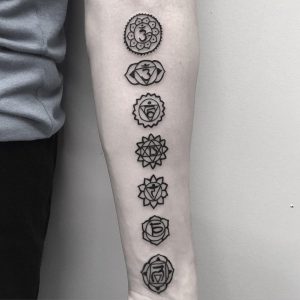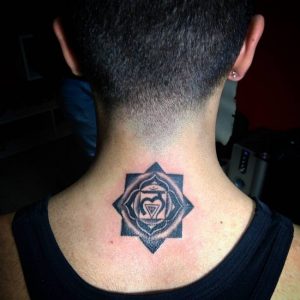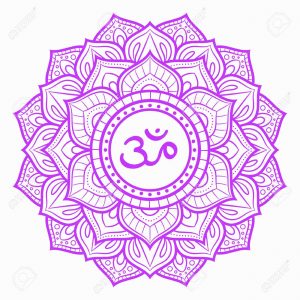Spiritual Symbols in Tattooing Part II – Chakras
With the proliferation of the practice of yoga and its philosophy, it is becoming increasingly common to see people inked with representations of what is known as “chakras,” or energetic wheels.
To simplify, one can say that according to yogic anatomy, there are seven major chakras in the body. They are located along the spine and correspond to various functions of the endocrine or the nervous system. They are represented by different colours and are connected to different organs, as well as emotional and mental states.
When these wheels “spin” at a healthy rate, that means that energy flows freely and we are in equilibrium. If one of them gets blocked, through trauma or general life imbalance, we also become out of whack, feeling off-kilter. We can become reactive, feel ungrounded, out of touch with what we want, our creative energy, and unable to communicate.

The material ones
The first chakra, the root chakra, Muladhara, is located at the base of the spine and is represented by the colour red. This is where our relationship to our most fundamental material needs reside, but also where our connection to family, home, a sense of belonging in the world, and material wealth, lives. Its element is earth.
The second is the sacral chakra or Swadisthana. It is orange, sits about two finger widths above the coccyx, and its element is water. The energy that resides here is sexual and creative, non-stagnant and fluid.
Then there is the Manipura chakra, located between the navel and the breast bone, in the area of the solar plexus. It is a bright yellow and is the seat of our power, self-esteem, purpose and drive, but also our passion and anger. Its element is fire so, basically, everything that brings the heat.

Moving into the heart and beyond
While the first three chakras are material and earthly, the next begins to move into the spiritual and ethereal realm. The heart chakra, a luscious green and located at the centre of the chest, is said to be the place where compassion, love and joy resides. But this is also where we hold on to grief and hurt from our past. Anahata’s element is air.
The fifth chakra is the throat chakra or Vishudda. Its element is ether, and it governs our communication, and when it is balanced, we are able to express ourselves authentically. Its colour is clear blue.
Then we arrive at what is usually talked about as the “third eye” or the Ajna chakra. This is not an “eye” per se, but it corresponds to the area in the brain in front of the pineal gland, which is often called the body’s “command centre,” as it governs the production of so many hormones. Ajna chakra is dark blue and is the seat for our intuition and wisdom.
The seventh and final of the major chakras is Sahasrara, the crown of the head, referred to as the thousand-petal lotus chakra. It is thought to be our source of enlightenment, through which we connect to something beyond ourselves or our understanding of divinity. Its colour is violet.

Poetic
Even if you don’t subscribe to an esoteric or yogic way of viewing the body and the energies (oxygen, hormones, organs) that govern it, it is difficult not to be swayed by the poetic nature of this system. Perhaps so many feel compelled to etch the chakras on their skin always to be reminded of the things we do that take us out of balance in our lives. Because if we truly pay attention and are honest with ourselves, we know what that is, whether we believe in energetic wheels or not.
